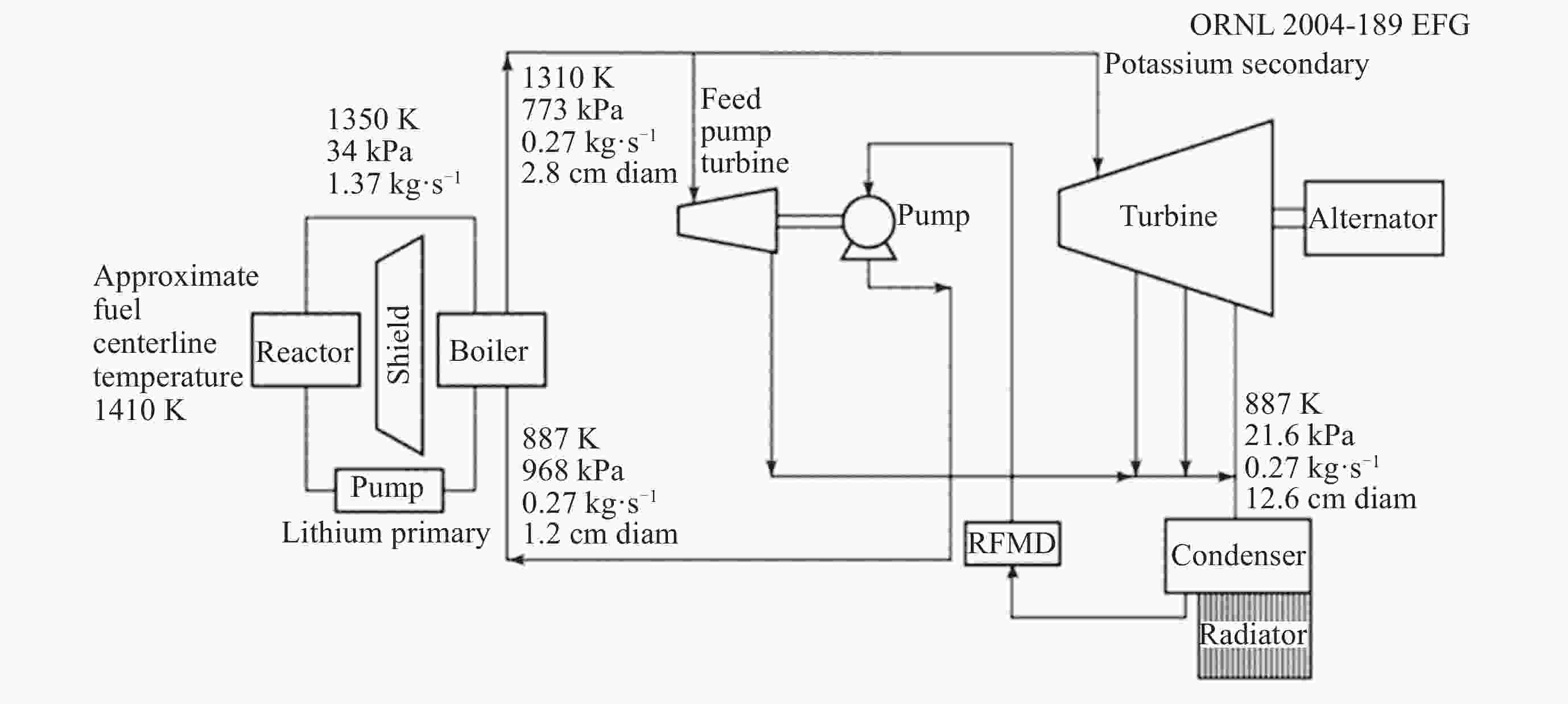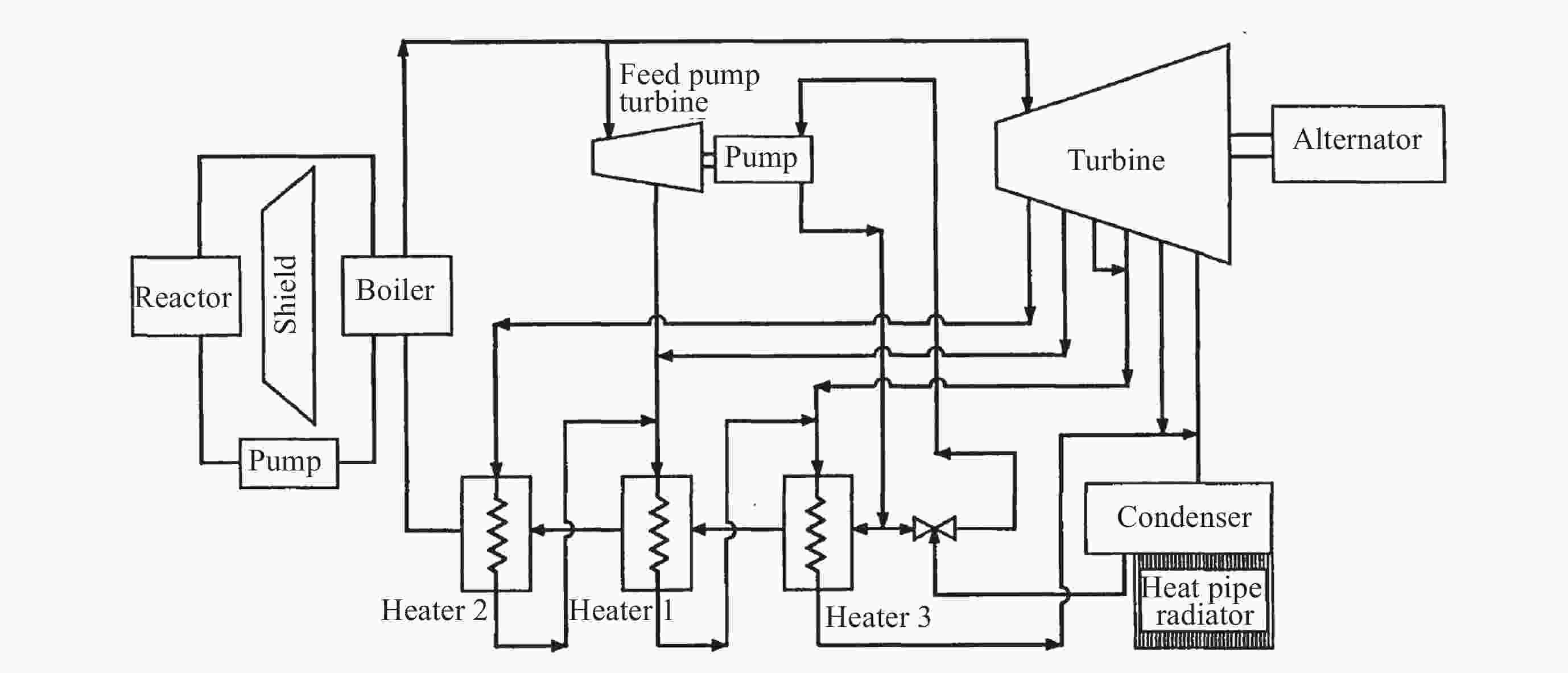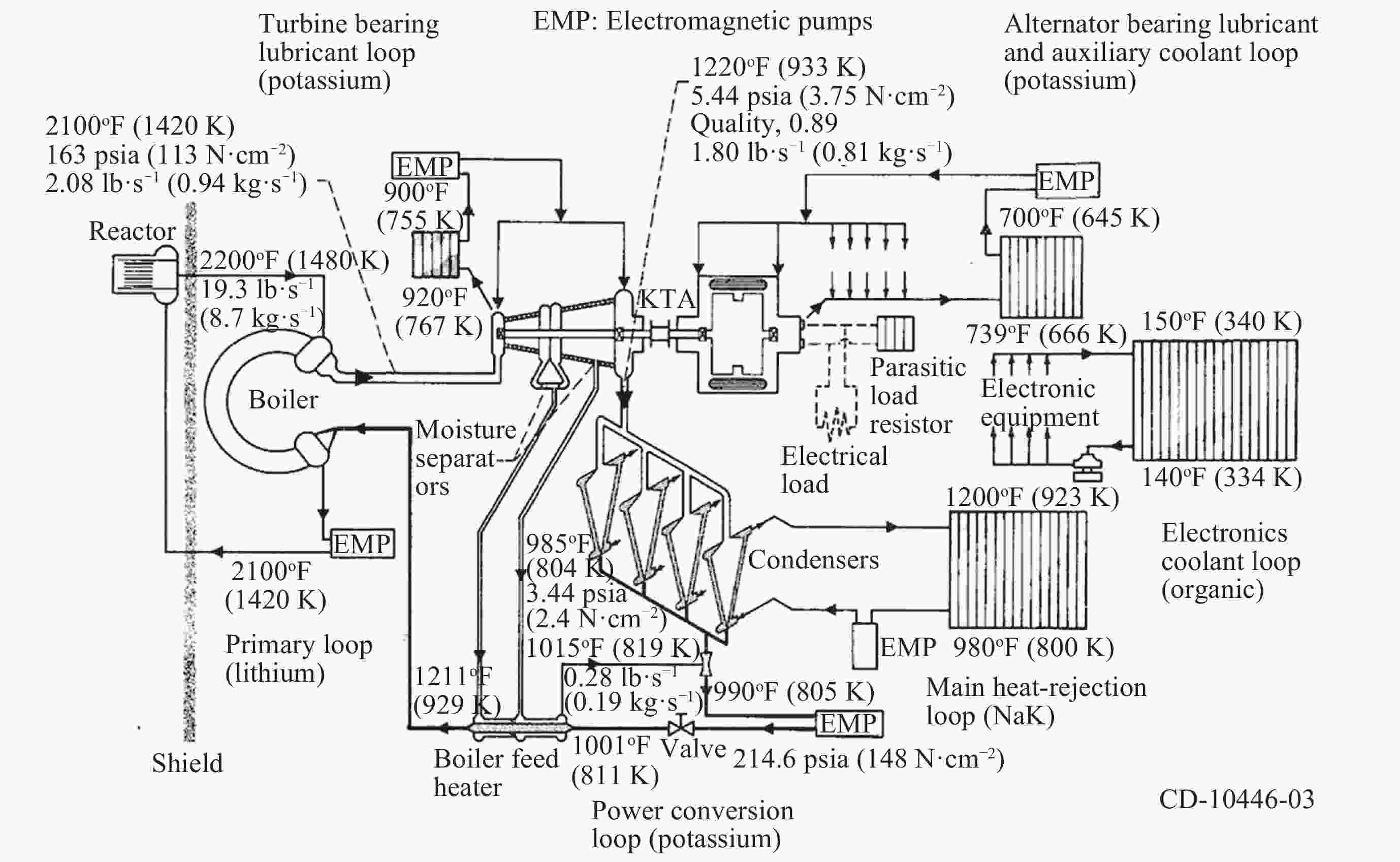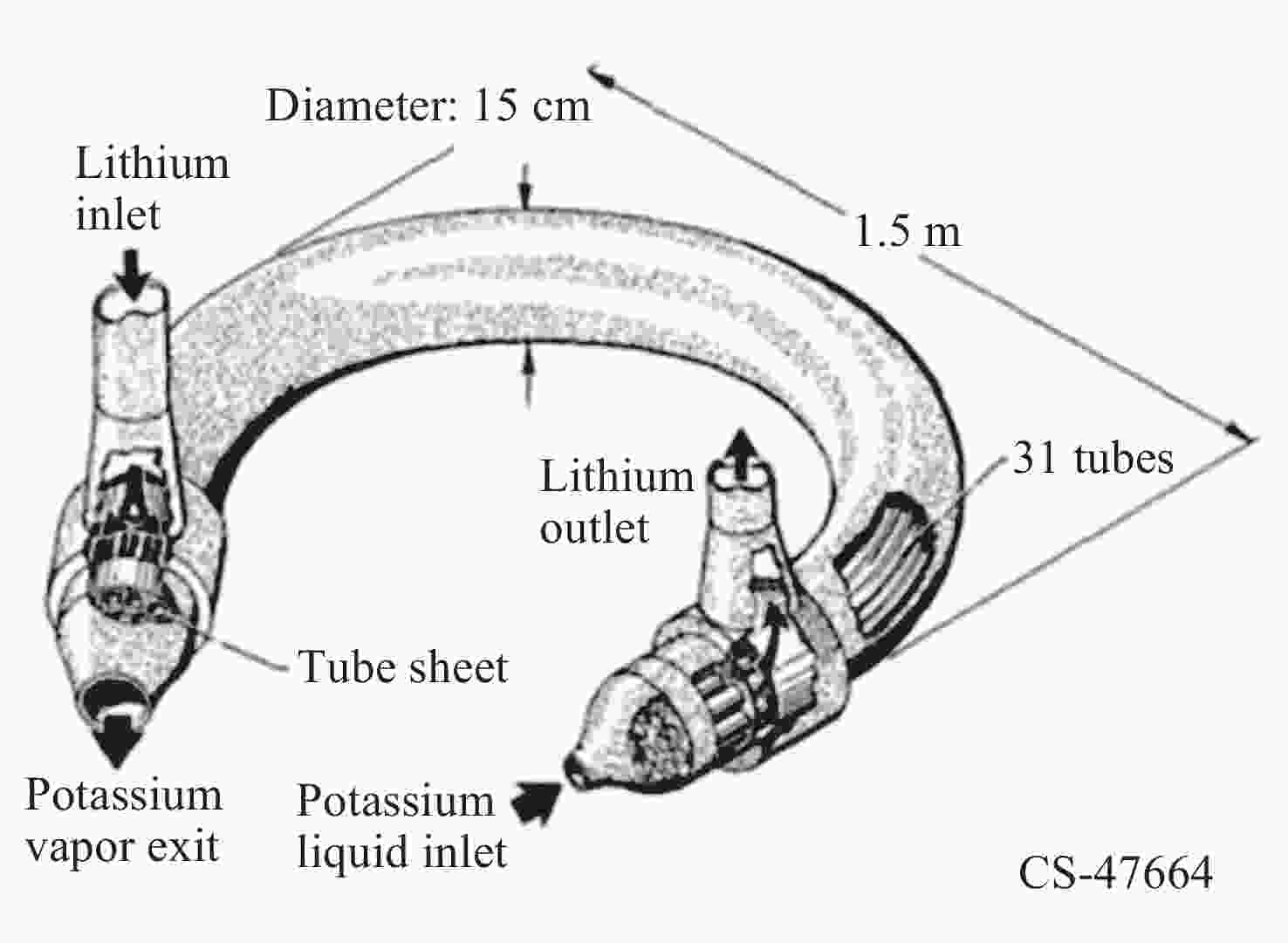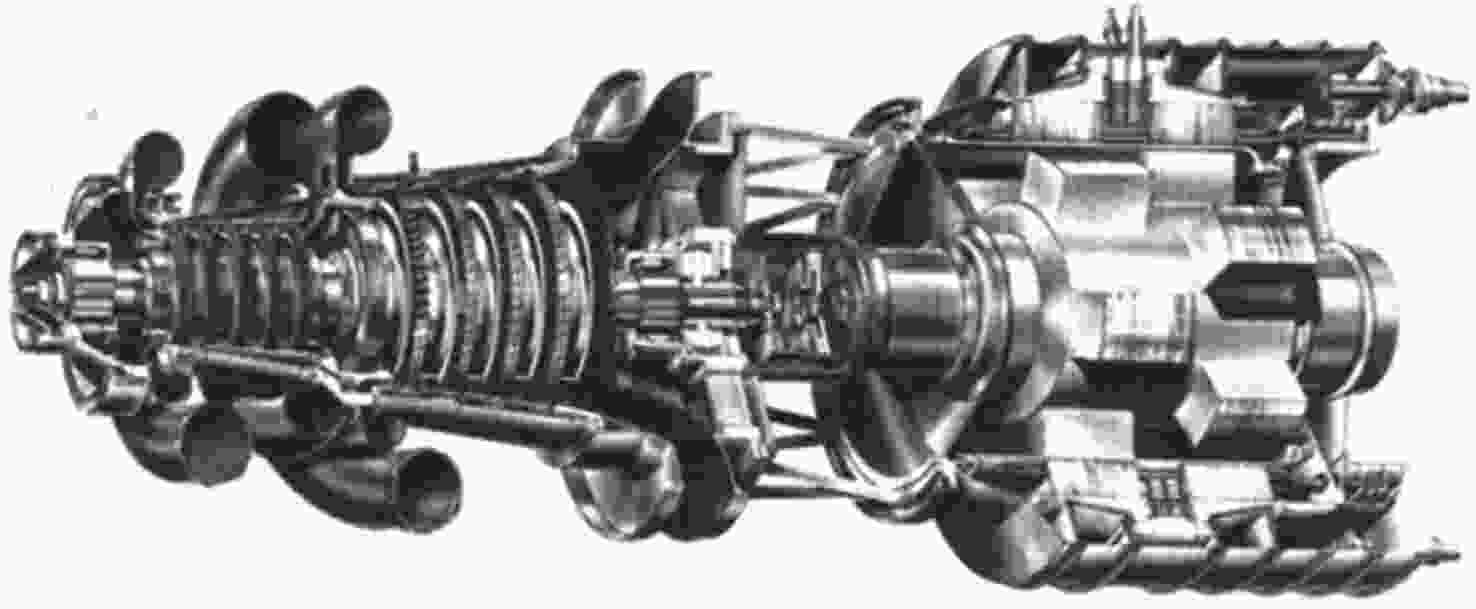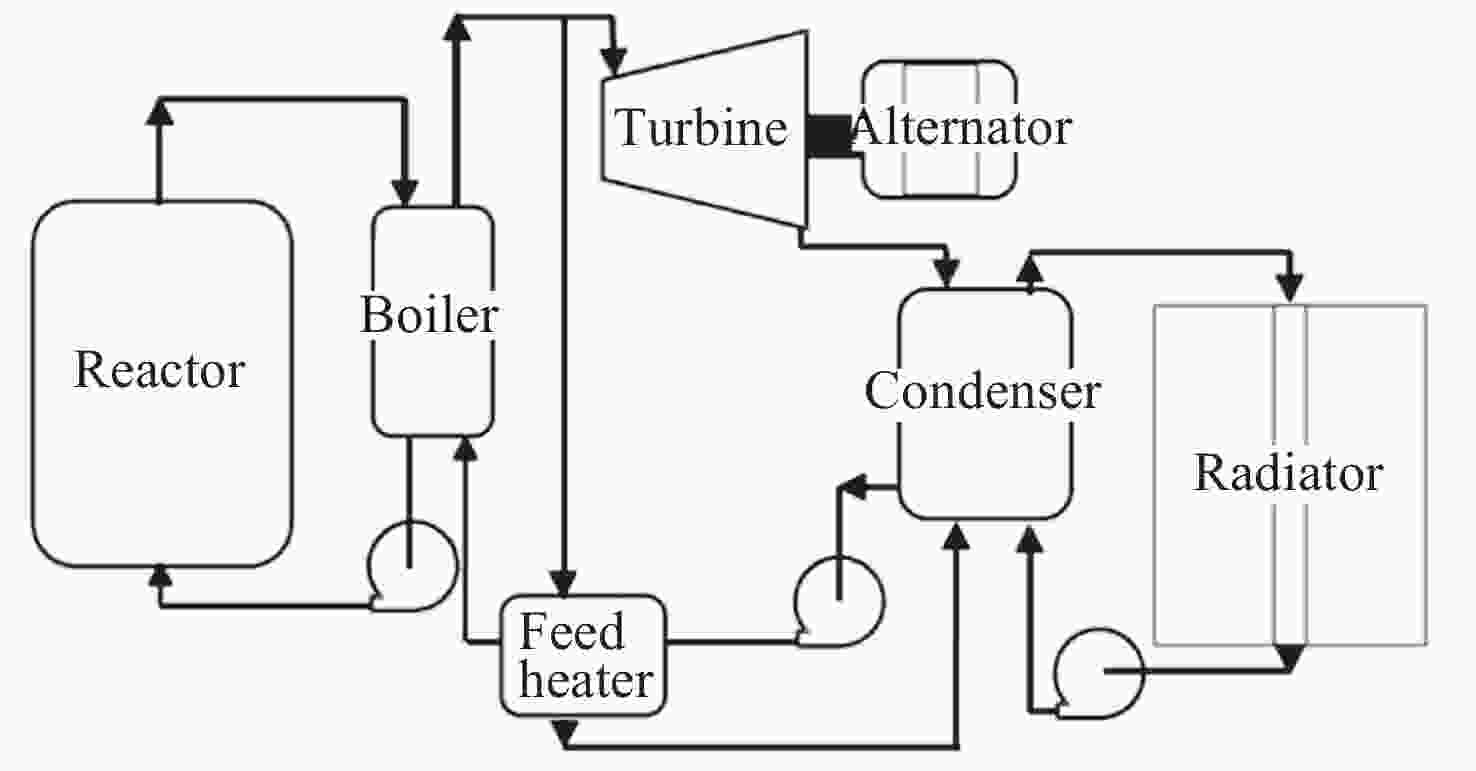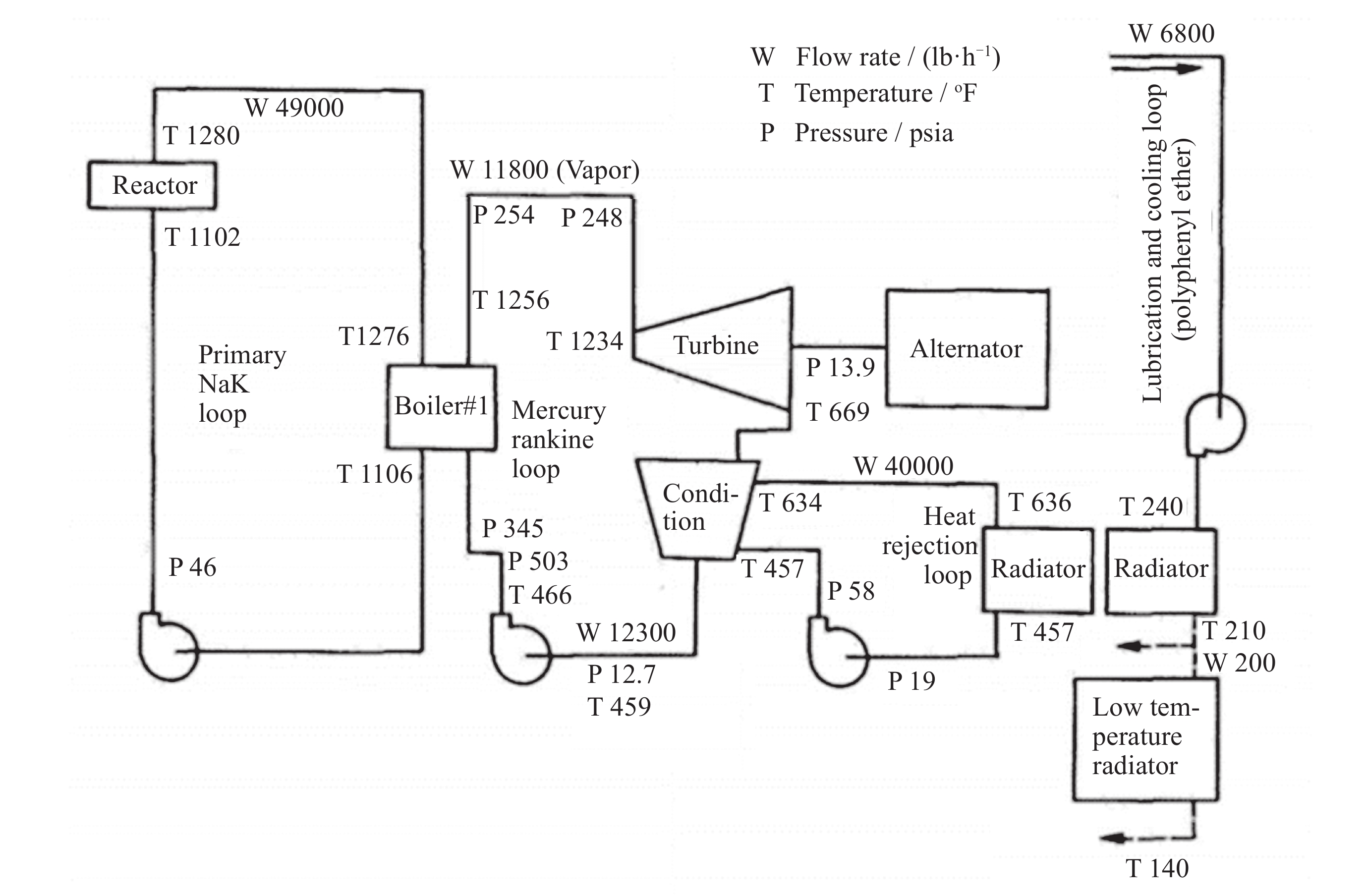Research Progress of Rankine Cycle System for Space Nuclear Power System
-
摘要: 空间核电源朗肯循环具有热电转换效率高、废热辐射面积小、功率变化灵活等特点, 是空间核反应堆电源领域的研究热点. 以空间核能朗肯循环的发展与研究现状为基础, 对空间核能朗肯循环的工质及选择标准和原则进行分析. 对不同功率等级的空间核能朗肯循环系统设计方案进行对比, 分析各个系统方案的反应堆设计、各回路工质选择、朗肯循环功率设计、关键部件设计等, 提出空间核电源朗肯循环的主要研究方向, 包括工质特性、朗肯循环关键部件、反应堆芯设计等, 而新型金属材料、高性能关键设备设计和地面集成方案等将是有待继续深入研究的关键技术问题. 分析结果可对中国未来空间核能朗肯循环的设计提供一定参考.Abstract: The space nuclear power Rankine cycle is a research hotspot in the field of space nuclear reactor power supply because of its high thermoelectric conversion efficiency, small waste heat radiation area and flexible power change. In this paper, based on the in-depth analysis of the development history of space nuclear power Rankine cycle at home and abroad and the research progress at home and abroad, the research progress of the workmass of space nuclear power Rankine cycle is sorted out, and the selection criteria and principles of workmass are summarized. In this paper, a detailed review of the design schemes of space nuclear energy Rankine cycle systems of different power levels is carried out, summarizing the reactor design, the selection of industrial materials for each circuit, the design of Rankine cycle power, the design of key components and other aspects of each system scheme, and it is found that the main research directions include the research on the characteristics of the industrial materials, the research on the key components of the Rankine cycle, the design of the reactor core, etc. The key technical issues to be further studied include research on new metal materials, high-performance key equipment design and ground integration program. The results of the analyses are intended to provide a certain reference for the design and research of the Rankine cycle for space nuclear energy in China in the future.
-
Key words:
- Space nuclear power /
- Rankine cycle /
- Liquid metal /
- Schematic design /
- Loop optimisation
-
表 1 四种液态金属热物性参数
Table 1. Thermophysical parameters of four liquid metals
元素 熔点/K 沸点/K 液体密度/(g·cm–3) 液体热容/(J·g–1·K–1) 液体汽化热/(kJ·g–1) 液体热导率/(W·m–1·K–1) 锂Li 453.5 1620 0.512 4.07 22.08 71.1 钠Na 371.0 1156 0.929 1.38 4.20 93.0 钾K 336.5 1033 0.850 0.84 2.55 102.4 汞Hg 234.0 630 13.590 0.14 0.29 8.3 表 2 回热和再热对100 kW系统效率和质量的影响
Table 2. Effect of feed heat and reheat on 100 kW system efficiency and mass
Number of feed
heatersReheat temperature/K Cycle efficiency/(%) Relative mass Δ mass /kg 0 0 23.6 1.00 0 3 0 24.8 0.97 –88 0 160 28.0 0.92 –256 3 160 31.5 0.86 –436 表 3 基于SP-100液态金属朗肯循环反应堆系统设计方案
Table 3. Design scheme of liquid metal Rankine cycle reactor system based on SP-100
Concept Fuel Clad Neutron spectrum Reactor coolant Coolant outlet temp/K Power conversion Technology base UN/Nb-1 Zr/Li-K UN Nb-lZr Fast Li 1350 K-Rankine SP-100 UN/Nb-1 Zr/Ga-K UN Nb-lZr Fast Ga 1350 K-Rankine SP-100 UN/Nb-1 Zr/Li-Na UN Nb-lZr Fast Li 1350 Na-Rankine SP-100 UN/Nb-1 Zr/Ga-Na UN Nb-lZr Fast Ga 1350 Na-Rankine SP-100 UN/ASTAR 811 C/Li-K UN ASTAR811 C Fast Li 1500 K-Rankine SP-100a UN/ASTAR 811 C/Ga-K UN ASTAR811 C Fast Ga 1500 K-Rankine SP-100a UN/ASTAR 811 C/Li-Na UN ASTAR811 C Fast Li 1500 Na-Rankine SP-100a 注 上角a表示改进型. 表 4 各种配置的朗肯循环分析
Table 4. Rankine cycle analysis for various configurations
Parameter UN/
Nb1 Zr/Li-KUN/
Nb1 Zr/Ga-KUN/
Nb1 Zr/Li-NaUN/
ASTAR811 C/
Li-KUN/
ASTAR811 C/
Ga-KUN/
ASTAR811 C/
Li-NaTurbine inlet temperature/K 1260 1260 1260 1410 1410 1410 Reactor thermal power/kW 59108 59108 62026 49819 49819 49436 Thermal efficiency/(%) 25.4 25.4 24.2 30.1 30.1 30.3 Heat exchanger mass/kg 2254 3296 1205 868 960 493 Power conditioning mass/kg 15106 15106 15106 15106 15106 15106 Radiator mass/kg 14654 42496 15313 11691 35092 11612 Shield mass/kg 9709 5621 9895 8216 3855 8196 Turbine/Generator mass/kg 43614 43614 292801 57820 57820 468938 Main radiator area/m2 3397 3397 3626 2665 2665 2635 Low-temperature radiator area/m2 283 283 289 264 264 263 Radiator mass/kg 11039 11039 11746 8789 8789 8696 Total mass/kg 96376 121172 346065 102490 121622 513041 Specific mass/(kg·kW–1) 6.43 8.08 23.07 6.83 8.11 34.2 -
[1] 苏著亭, 杨继材, 柯国土. 空间核动力[M]. 上海: 上海交通大学出版社, 2016SU Zhuting, YANG Jicai, KE Guotu. Space Nuclear Power[M]. Shanghai: Shanghai Jiao Tong University Press, 2016 [2] GUHARKIN H E. Space Nuclear Power Sources “Romanska” and “Yenisei” with Thermoelectric Conversion and Thermionic Conversion[M]. LIU Shu, ZHANG Ling, SONG Chenwei, trans. Beijing: China Atomic Energy Publishing House, 2016: 61-66 [3] 马世俊, 杜辉, 周继时, 等. 核动力航天器发展历程(下)[J]. 中国航天, 2014(5): 32-35MA Shijun, DU Hui, ZHOU Jishi, et al. Development history of nuclear powered spacecraft (part 2)[J]. Aerospace China, 2014(5): 32-35 [4] WANG C L, LIU T C, TANG S M, et al. Thermal–hydraulic analysis of space nuclear reactor TOPAZ-II with modified RELAP5[J]. Nuclear Science and Techniques, 2019, 30(1): 12 doi: 10.1007/s41365-018-0537-3 [5] STAUB D W. SNAP Programs: Summary Report[R]. Canoga Park: Atomics International Division, 1973 [6] PITTS J H, JESTER M H L. Rankine Cycle Systems Studies for Nuclear Space Power[R]. Livermore: Lawrence Radiation Laboratory, 1968 [7] MASON L S, BLOOMFIELD H S, HAINLEY D C. SP-100 power system conceptual design for lunar base applications[C]//6th Symposium on Space Nuclear Power Systems. Albuquerque: Institute for Space Nuclear Power Studies, 1989 [8] LAHEY JR R T, DHIR V. Research in Support of the Use of Rankine Cycle Energy Conversion Systems for Space Power and Propulsion[R]. Hanover: NASA Center for Aerospace Information, 2004 [9] 张震. 空间核动力金属朗肯循环动态热电转换系统仿真分析及优化[D]. 哈尔滨: 哈尔滨工业大学, 2021. DOI: 10.27061/d.cnki.ghgdu.2021.003978ZHANG Zhen. Simulation Analysis and Optimization of Metal Rankine Cycle Dynamic Thermoelectric Conversion System for Space Nuclear Power[D]. Harbin: Harbin Institute of Technology, 2021. DOI: 10.27061/d.cnki.ghgdu. 2021.003978 [10] 程献伟. 空间核能液态金属朗肯循环的热力学性能分析[D]. 哈尔滨: 哈尔滨工业大学, 2017CHENG Xianwei. Thermodynamic Analysis of Space Nuclear Power System Based on Liquid Metal Rankine Cycle[D]. Harbin: Harbin Institute of Technology, 2017 [11] JARRETT A A. SNAP 2: Summary Report[R]. Canoga Park: Atomics International Division, 1973 [12] 许春阳. 俄罗斯兆瓦级空间核动力装置研发进展(内部报告)[R]. 北京: 中国核科技信息与经济研究院, 2012XU Chunyang. Research and Development Progress of Russian Megawatt Space Nuclear Power Plant (Internal Report)[R]. Beijing: China Institute of Nuclear Information & Economics, 2012 [13] YOUNG H C, CLARK D L, GRINDELL A G. Comparison of Boiler Feed Pumps for Cesium and Potassium Rankine Cycle Systems[R]. Oak Ridge: Oak Ridge National Laboratory, 1968 [14] FRAAS A P, BURTON D W, LAVERNE M E, et al. Design Comparison of Cesium and Potassium Vapor Turbine-Generator Units for Space Power Plants[R]. Oak Ridge: Oak Ridge National Laboratory, 1969 [15] YOUNG H C, GRINDELL A G. Summary of Design and Test Experience with Cesium and Potassium Components and Systems for Space Power Plants[R]. Oak Ridge: Oak Ridge National Laboratory, 1967 [16] THUR G M. SNAP-8 power conversion system assessment[C]//Intersociety Energy Conversion Engineering Conference. Boulder: National Aeronautics and Space Administration, 1968 [17] GERTSMA L G, THOLLOT P A, MEDWID D W. Review of the double containment Ta/SS SNAP-8 boiler[C]//Intersociety Energy Conversion Engineering Conference. Boulder: National Aeronautics and Space Administration, 1968 [18] 马世俊, 唐玉华, 朱安文, 等. 空间核动力的进展[M]. 北京: 中国宇航出版社, 2019MA Shijun, TANG Yuhua, ZHU Anwen, et al. Progress in Space Nuclear Power[M]. Beijing: China Aerospace Publishing House, 2019 [19] YODER G L, CARBAJO J J, MURPHY R W, et al. Potassium Rankine cycle system design study for space nuclear electric propulsion[C]//3rd International Energy Conversion Engineering Conference. San Francisco: AIAA, 2005: 5637 [20] HELLER J A, MOSS T A, BARNA G J. Study of a 300-Kilowatt Rankine-Cycle Advanced Nuclear-Electric Space-Power System[R]. Washington: National Aeronautics and Space Administration, 1969 [21] MILLER J V. Characteristics of A Space-Power Nuclear Reactor with Considerations for Venting or Containing Gaseous Fission Products[R]. Washington: National Aeronautics and Space Administration, 1968 [22] VARLJEN T C. The Transport of Atomized Drops in Wet Vapor Turbines[R]. Pittsburgh: Westinghouse Astronuclear Laboratory, 1968 [23] RACKLEY R A. Potassium Turboalternator (KTA) Preliminary Design Study: Volume III-Phase II KTA Final Design[R]. Washington: National Aeronautics and Space Administration, 1970 [24] LONGHURST G R, HARVEGO E A, SCHNITZLER B G, et al. Multi Megawatt Power System Analysis Report[R]. Idaho Falls: Idaho National Laboratory, 2001 [25] PITTS J H, WALTER C E. Conceptual design of a 10-MWe nuclear Rankine system for space power[J]. Journal of Spacecraft and Rockets, 1970, 7(3): 259-265 doi: 10.2514/3.29917 [26] WERNER R W, CARLSON G A. Heat Pipe Radiator for A 50-MWt Space Power Plant[R]. Livermore: Lawrence Radiation Laboratory, 1967 [27] LONGHURST G R, SCHNITZLER B G, PARKS B T. Multi-Megawatt Power system trade study[J]. AIP Conference Proceedings, 2002, 608(1): 1075-1083 [28] Morgon R. Comparison of high power nuclear systems for space[C]//Proceedings of the 18th Intersociety Energy Conversion Conference, Orlando, FL, USA. 1983: 21-26 [29] TRUSCELLO V C, RUTGER L L. The SP‐100 power system[J]. AIP Conference Proceedings, 1992, 246(1): 1-23 [30] 中国核科技信息与经济研究院. 世界反应堆大全: RAPID星表反应堆电源[M]. 北京: 原子能出版社, 2015: 152China Institute of Nuclear Technology Information and Economics. World Reactor Encyclopedia: RAPID Catalogue Reactor Power Supply[M]. Beijing: Atomic Energy Publishing House, 2015: 152 [31] 张震, 张昊春, 张冬, 等. 兆瓦级空间核电源碱金属朗肯循环热电转换系统设计[J]. 上海航天(中英文), 2022, 39(2): 76-84 doi: 10.19328/j.cnki.2096-8655.2022.02.012ZHANG Zhen, ZHANG Haochun, ZHANG Dong, et al. Design of alkali metal Rankine cycle thermoelectric conversion system for megawatt space nuclear plant[J]. Aerospace Shanghai (Chinese & English), 2022, 39(2): 76-84 doi: 10.19328/j.cnki.2096-8655.2022.02.012 [32] 张昊春, 程献伟, 余红星, 等. 空间核能液态金属朗肯循环的热力学性能分析[J]. 工程热物理学报, 2018, 39(2): 242-248ZHANG Haochun, CHENG Xianwei, YU Hongxing, et al. Thermodynamic analysis of space nuclear power system based on liquid metal Rankine cycle[J]. Journal of Engineering Thermophysics, 2018, 39(2): 242-248 -
-





 王洁炜 男, 1998年2月出生于浙江省绍兴市, 2021年本科毕业于东南大学, 现为中国原子能科学研究院硕士研究生, 研究领域为特种动力反应堆热工水力研究. E-mail:
王洁炜 男, 1998年2月出生于浙江省绍兴市, 2021年本科毕业于东南大学, 现为中国原子能科学研究院硕士研究生, 研究领域为特种动力反应堆热工水力研究. E-mail: 
 下载:
下载:
